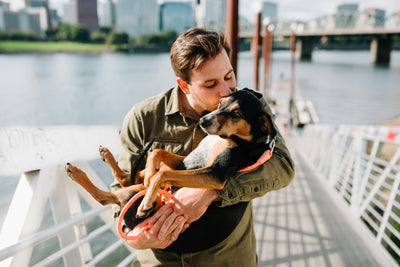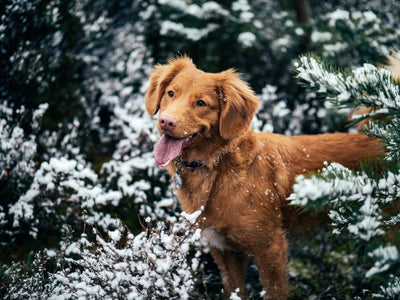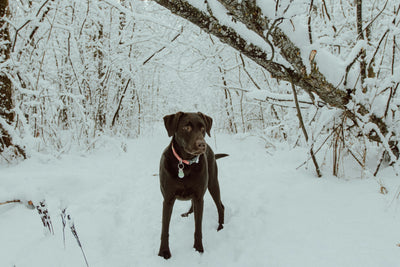Walking your dog is an important part of keeping them healthy and happy. However, during the winter months, it can be challenging to keep your furry friend comfortable and safe while enjoying the great outdoors. Cold weather, snow, and ice can be tough on your dog's paws, and the shorter days can make it difficult to walk your dog during daylight hours. But with a little bit of planning and preparation, you can enjoy the winter weather together safely. In this blog post, we'll provide 30 tips to help you walk your dog during the winter. From dressing appropriately to keeping your dog's paws clean and dry, these tips will help you and your dog make the most of the winter season. Without further adieu:
1. Dress appropriately for the weather: Winter weather can be harsh, so it's important to dress appropriately to keep yourself and your dog warm. Wear warm clothing, such as a coat, hat, gloves, and waterproof boots. This will not only keep you warm, but also protect your feet and legs from snow and slush.
2. Keep your dog on a leash: It's important to keep your dog on a leash during the winter to prevent them from running off or getting lost in the snow. A leash will also keep your dog safe if you come across any hazards like icy roads or frozen ponds.
3. Keep an eye on the weather forecast: Before heading out on a walk, check the weather forecast to avoid dangerous conditions like blizzards or extreme cold. This will also help you plan for the appropriate clothing and gear for your walk.
4. Consider using a coat or sweater for your dog: Dogs with short hair can get cold more easily than dogs with longer hair, so consider using a coat or sweater to keep your dog warm. This will also help them retain their body heat and stay comfortable during the walk.
5. Bring a portable water bowl: The cold weather can make it difficult for your dog to drink from a regular bowl, so bring a portable water bowl to prevent your dog from drinking snow and getting dehydrated.
6. Use a leash with reflective material: Walking your dog in the dark during the winter can be dangerous, so use a leash with reflective material to make it easier for you and your dog to be seen by cars and other people.
7. Keep your dog's paws clean and dry: Snow, slush, and salt can be tough on your dog's paws, so keep them clean and dry by wiping them off with a towel or using booties. This will also prevent salt and chemicals from causing irritation or cracking.
8. Be mindful of the salt and chemicals used to melt snow and ice: The salt and chemicals used to melt snow and ice can be harmful to your dog's paws, so try to avoid walking on treated surfaces if possible. If your dog does come into contact with these substances, wipe their paws off with a damp towel to remove any residue.
9. Avoid walking on frozen ponds or lakes: Although it may be tempting to walk on frozen ponds or lakes, the ice may not be thick enough to support your dog's weight. This can be dangerous and can lead to injury.
10. Keep your walks shorter during the winter: The cold weather can be taxing on your dog, so keep your walks shorter during the winter to prevent your dog from getting too cold.
11. Bring a flashlight or headlamp: Walking your dog early in the morning or in the evening during the winter can be dark, so bring a flashlight or headlamp to light your way and make you and your dog more visible.
12. Be aware of your dog's energy levels: Cold weather can drain your dog's energy, so be aware of their energy levels during the walk and take breaks if they seem tired.
13. Keep an eye out for signs of hypothermia or frostbite: Look out for signs of hypothermia or frostbite, such as shivering, lethargy, or discolored skin. If you notice any of these symptoms, bring your dog inside and warm them up immediately.
14. Use a shorter leash: Walking your dog on a shorter leash helps to prevent your dog from getting tangled up and helps you maintain control of the pace of the walk and avoid potentially dangerous or slippery areas.
15. Keep your dog's nails trimmed: Long nails can make it difficult for your dog to walk on icy surfaces and can lead to slips and falls. Keep your dog's nails trimmed to prevent them from slipping and to improve their footing on winter terrain.
16. Bring extra water bottles and a portable water bowl: Your dog may need more water during the winter, especially if they're wearing a coat or sweater. Bring extra water bottles and a portable water bowl to ensure that your dog stays hydrated during the walk.
17. Try to stick to cleared sidewalks and paths: Snow and ice can make it difficult to walk on uneven terrain, so try to stick to cleared sidewalks and paths to avoid slipping on ice.
18. Bring a first aid kit: Accidents can happen, so bring a first aid kit with you on your walk. Make sure it includes bandages, gauze, and antiseptic cream, in case of any injuries.
19. Bring a blanket or towel: If your dog gets wet during the walk, bring a blanket or towel to help them dry off. Wet dogs can easily get cold, so it's important to dry them off as soon as possible.
20. Consider using a dog backpack: A dog backpack can be a useful way to carry your dog's essentials like water, food, blanket, and first aid kit. This will free your hands and make it easier to carry everything you need for the walk.
21. Research the areas you plan to walk your dog in advance: Research the areas you plan to walk your dog in advance, to avoid any hazards and to familiarize yourself with the best routes.
22. Keep your dog on a short leash when walking near busy roads: It's important to keep your dog on a short leash when walking near busy roads to prevent them from running into traffic.
23. Have a plan in case you get lost or separated from your dog: Have a plan in case you get lost or separated from your dog. Make sure you have your dog's identification and contact information with you, and consider bringing a whistle or bell to use as a signal to your dog in case of emergency.
24. Avoid walking your dog in extreme cold temperatures: Your dog can get hypothermia just like you, so avoid walking them in extreme cold temperatures. Keep an eye on the weather forecast and adjust your walk accordingly.
25. Bring a whistle or bell to use as a signal: Bring a whistle or bell to use as a signal to your dog in case you need to call them back in a hurry. This can be useful in crowded areas or if your dog gets loose.
26. Keep your dog's vaccinations and identification up to date: Keep your dog's vaccinations and identification up to date in case they get lost or separated from you.
27. Train your dog to come to you when called: Train your dog to come to you when called, in case you need to call them back in a hurry. This can be a lifesaver in emergency situations.
28. Use a harness instead of a collar: Use a harness instead of a collar to prevent your dog from slipping out of it. Harnesses provide more support and control, and they're less likely to come off in case of emergency.
29. Make sure your dog has enough food and water before starting your walk: Make sure your dog has enough food and water before starting your walk, to ensure that they have enough energy for the walk.
30. Bring poop bags to clean up after your dog: Bring poop bags to clean up after your dog, and dispose of them properly. Not only is it more hygienic, but it is also important to keep the environment clean.
Walking your dog during the winter can be a fun and enjoyable experience for both you and your furry companion, as long as you take the necessary precautions to keep them safe and comfortable. Remember to dress appropriately, keep your dog on a leash, and watch the weather forecast. Consider using a coat or sweater for your dog, bring a portable water bowl, and use a leash with reflective material. Keep your dog's paws clean and dry, be mindful of the salt and chemicals used to melt snow and ice, and avoid walking on frozen ponds or lakes. Keep your walks shorter, bring a flashlight or headlamp, and be aware of your dog's energy levels. Keep an eye out for signs of hypothermia or frostbite, use a shorter leash in crowded areas, and keep your dog's nails trimmed. With these tips in mind, you and your dog can enjoy the winter weather together safely.






